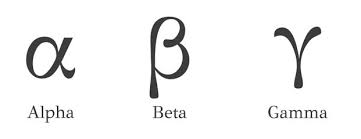Unit 4 - Chemistry 9
1/13
There's no tags or description
Looks like no tags are added yet.
Name | Mastery | Learn | Test | Matching | Spaced |
|---|
No study sessions yet.
14 Terms
Alpha, Beta, Positron Emission and Gamma Greek Letters

Alpha, Beta, Positron Emission and Gamma Symbol
4/2 a,
0/-1 e
0/+1 e
Y
Alpha, Beta, Positron Emission and Gamma: how is the atomic number changed?
-2
+1
-1
Same
Alpha, Beta, Positron Emission and Gamma: How is the mass number changed?
-4
same
same
same
Alpha, Beta, Positron Emission and Gamma: amount of energy
low
medium
medium
high
Alpha, Beta, Positron Emission and Gamma: stopped by
Paper
Aluminum
Aluminum
Lead
Half life: time/time
take time divided by time to get the half life
divide by 2 the number of half lives (if there are 4 half lives, divid the mass by 2 four different times)
Half life: mass/mass
Divide starting mass by two till you get the after mass
Divide the time by two the number of times the mass was divided (if you divided the mass 3 times, divide the time 3 times)
Properties of metal and nonmetalsMetal: Good conductors, luster, malleability, ductile most are solid at room temp, except mercury
Nonmetals; Poor conductors, brittle solids, most gasses at room temp, except bromine
Atomic radius
Total distance form an atoms nucleus to the outermost electron orbital
It increases as it goes down and decreases as you go to the right
Electronegativity
Measure of an atoms ability to attract shared electrons to itself
Decreases as it goes down and increases as it goes right
Ionization energy
The amount of energy needed to remove a electron from an isolated atom or molecule
Decreases as it goes down and increases as it goes right
How light is emitted
When an electron gains energy as it moves up from the ground state to the excited state, and when it falls back down it creates light by releasing energy in the form of photons.